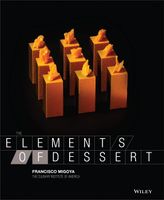Advertisement
The Rubbed Dough Method or the Cut-in Method
Appears in
Published 2012
This method will not be widely used in this book, since it is generally used for breakfast pastries such as scones and biscuits as well as for pie dough. However, it is important to understand it as a basic pastry method. It is known as the rubbed dough method because originally this dough was made only by hand by rubbing cold pieces of butter into flour with the palms of one’s hands. Now it is not limited to hand mixing; it can be done in an electric mixer using a paddle attachment to obtain the same result. The crux of this method is that the dough is made by rubbing butter into flour (and other ingredients such as cold water or heavy cream) in order to obtain a flaky dough. Flakiness is determined by how much or how little the butter is cut into the flour. The smaller the pieces of butter, the less flaky the dough will be. The larger the pieces of butter, the flakier the dough will be. Of course, there is such a thing as a piece of butter that is too large; in this case it will just melt out of the dough and not provide any flakiness.


